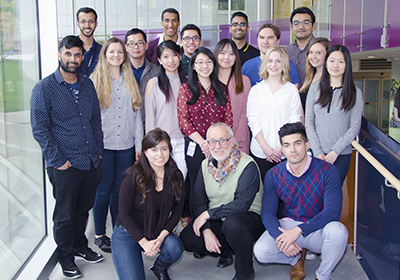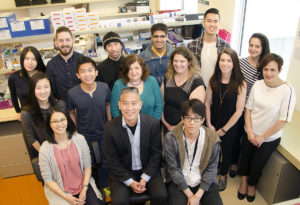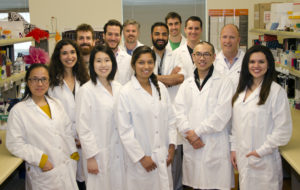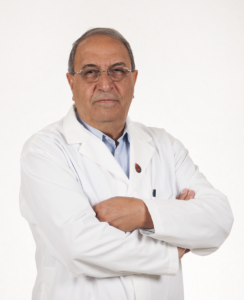 Four ICORD PIs have received Innovation to Commercialization (I2C) grants from the Michael Smith Foundation for Health Research. This funding is designed to support translational researchers in the health and health services sectors — to advance their discoveries or inventions towards commercialization resulting in products or technologies that improve health outcomes, and enrich the health innovation ecosystem of BC.
Four ICORD PIs have received Innovation to Commercialization (I2C) grants from the Michael Smith Foundation for Health Research. This funding is designed to support translational researchers in the health and health services sectors — to advance their discoveries or inventions towards commercialization resulting in products or technologies that improve health outcomes, and enrich the health innovation ecosystem of BC.
Dr. Andrei Krassioukov: Servo-controlled device to maintain physiological functioning

The Krassioukov lab
A serious complication of SCI is orthostatic hypotension, sudden falls in blood pressure upon standing. Such dysregulated blood pressure can also be caused by multiple sclerosis, autonomic failure, autonomic neuropathy, or neurological cancers. A high quality, efficient, and cost effective method is needed to help these individuals regulate their blood pressure. Dr. Krassioukov has developed a device and algorithm for controlling autonomic processes in patients using electrical stimulation, based on the surprising discovery that electrical stimulation of the spinal cord circuitry caudal to SCI can control the activity of disconnected sympathetic circuitry to regulate blood pressure. The device can be individualized, and electrical output may increase or decrease based on the information received from the patient’s physiological monitor. Dr. Krassioukov’s product may improve patients’ control of autonomic functions such as dysregulated blood pressure due to SCI or other injuries or diseases, improving their quality of life and ability to manage symptoms, at a lower cost and with improved effectiveness than current methods.
Dr. Brian Kwon: Near infrared spectroscopy for the hemodynamic monitoring of acute spinal cord injury

The Kwon Lab
One of the only treatments that could potentially improve paralysis in patients who have suffered an acute traumatic SCI is the elevation of the mean arterial blood pressure (MAP) to provide enough blood supply to the injured spinal cord. It is, however, difficult to know what the MAP target should be for a given patient to optimize their neurologic recovery. Currently there is no measurement tool that provides real-time information about the spinal cord blood supply and oxygenation, and allows them to know if their efforts to elevate blood pressure are actually improving (or worsening) the injured spinal cord. Such a tool would provide information to guide clinicians in their treatment decisions and allow them to personalize their care and optimize neurologic outcomes. Dr. Kwon will explore the potential of near-infrared spectroscopy (NIRS) as a monitoring tool to provide this information, with the explicit goal of developing this technology into a device that can be commercialized to be used in SCI patients. NIRS works by shining near-infrared (NIR) light through tissues and then recording how much light is transmitted versus how much is absorbed by molecules within the tissue. By measuring near infrared light absorption in tissue, NIRS can measure how much oxygen and blood is being delivered, potentially informing us of whether cells within the tissue are being irreversibly injured due to oxygen deprivation. Dr. Kwon’s research will translate a promising technology (NIRS) into a clinical application for acute SCI patients. His initiative is focused on providing a tool that will assist clinicians in their hemodynamic management of acutely injured patients during a time when their efforts greatly impact patients’ neurologic outcomes.
Dr. David Granville: A novel therapeutic for inflammatory skin diseases

The Granville Lab
Dr. Granville’s laboratory has identified an enzyme, GzmB, which is secreted by immune cells and is believed to contribute to the onset and progression of a number of autoimmune and/or chronic skin diseases. In collaboration with the UBC Centre for Drug Research and Development and the UBC spin-off company, viDA Therapeutics, they have developed a topical drug that targets and inhibits the activity of this destructive enzyme. Preliminary studies suggest that application of this topical GzmB inhibitor can be used to treat autoimmune skin diseases in which this enzyme is abundant. Their MSFHR-funded project will build upon these initial studies and further explore to utility of this drug for the treatment of autoimmune conditions such as discoid lupus erythematosus, autoimmune blistering and other conditions associated with inflammation and impaired healing. Dr. Granville’s team has also developed a systemic inhibitor of GzmB that is under investigation for the treatment of progressive multiple sclerosis and prevention of secondary damage in spinal cord injury.
Dr. Aziz Ghahary: Liquid skin substitute accelerates burn and non-healing wounds

Dr. Ghahary
Self-expanded mesh grafts are routinely used to treat large burn injuries and skin defects. Although this treatment saves lives, the healed tissue has a fish net-like appearance, a disfigurement that can be devastating for patients. Furthermore, chronic and non-healing wounds seen in the elderly and diabetic patients and those with disabilities such as spinal cord injured patients are the most difficult and costly to treat. Dr. Ghahary’s lab has developed a novel, shelf-ready powdered reconstitutable liquid skin substitute called “MeshFill”. MeshFill is liquid at low temperatures and solidified when it is applied to a wound site. As MeshFill is a liquid scaffold, it fills up any cavities, gaps and void areas seen in different chronic wounds and any other injuries. The therapeutic use of MeshFill would greatly reduce patient suffering, as well as reducing the economic and social costs of chronic and burn wounds. With this funding, Dr. Ghahary will evaluate MeshFill’s safety, effectiveness, feasibility and functionality in animal models. Subject to successful results from these experiments, he will then refine MeshFill’s preclinical safety, manufacturing, sterilization, packaging, and a scaling-up strategy in order to assemble a shelf-ready product.

